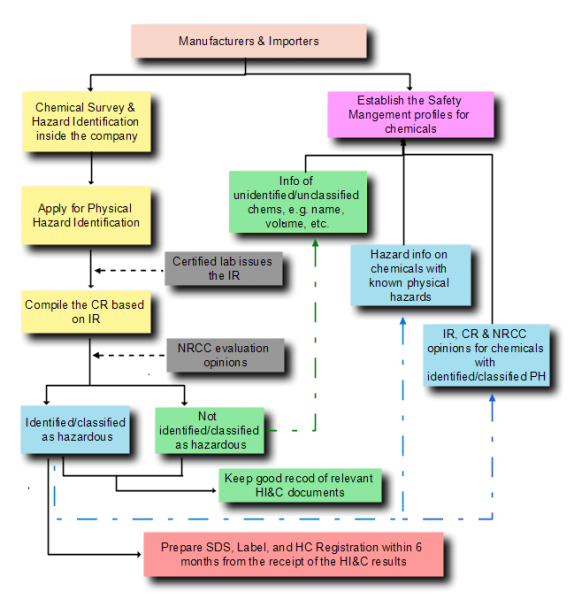China SAWS is seeking public comments on the draft “Measures for the Management of Physical Hazard Identification and Classification for Chemicals” by the deadline of 4 January 2013. Formulated in the context of the SAWS Order 53 and the State Council Decree 591, the draft measures are designed to promote safety control over chemicals with unknown physical hazards. Presently, China’s chemical manufacturers and importers will be facing a new mandatory program, that is, to conduct physical hazard identification and classification for chemicals with unidentified hazards. If identified as hazardous, the chemicals must be registered according to the SAWS Order 53.
Recent update: English version of the draft measures is available now in our regulatory database! You are welcome to leave comments on ChemLinked and we are happy to pass your feedbacks on the proposal to the SAWS.
The whole draft comprises six chapters, with Chapter One governing general principles and subject scope; Chapter Two stipulating main obligations required of chemical companies; Chapter Three managing the qualifications of certified identification institutions; Chapter Four explicating the content of physical identification & classification; Chapter Five laying down legal liabilities and penalties and Chapter Six attaching supplementary instructions on exemptions, joint application and fee charging items. Chapter One, Two and Four are extremely important to potential chemical companies in need of chemical physical identification and classification.
What is chemical physical hazard identification/classification?
The physical hazard identification is to determine hazard characteristics of chemicals such as flammability, explosiveness, corrosion, fire-assistance, self-reaction and reaction when in contact with water, etc. The physical hazard classification of a chemical is conducted through assessment of its physical hazard identification result and relevant data documents.
What chemicals are required to take physical hazard identification & classification?
1) Chemicals listed in the C&L Inventory (Catalogue of Hazardous Chemicals), yet found to have newly discovered physical hazards;
2) Mixtures containing more than one component substance listed in the Inventory with (known) physical hazards;
3) Chemicals that are not listed in the Inventory, but with unknown physical hazards; and
4) Newly developed chemicals for which physical hazard data are lacking.
What information will be incorporated into the Identification Report (IR) and Classification Report (CR) ?
Upon receipt of a company’s application, a state certified institution should issue within 20 working days the identification report for physical hazards (three categories of chemicals — explosives, self-reactive substances and mixtures and organic peroxides are excluded). A complete identification report includes the following information:
1) Chemical name;
2) Applying chemical company;
3) Identification item(s) with their standards and methods;
4) Equipment employed;
5) Identification conclusion; and
6) Other information required in the identification guidelines for physical hazard identification.
A Classification Report should be produced by the applying company, based on the Identification Report issued or other physical hazard data held on hand, and then submitted to the NRCC. The Report includes the following:
1) Chemical name;
2) Important components;
3) Identification Report and other related data and sources; and
4) Classification results for chemical physical hazards.
The testing institutions need to keep samples for at least 180 days and documentation on record for at least 5 years, respectively. When the Classification Report reaches the NRCC, after the comprehensive analysis and assessment lasting up to 30 working days, a final conclusion on whether to approve the classification will be issued and delivered to the applying company. If there is any dissents to the conclusion drawn by the NRCC, companies have the right to request for arbitration from the technical committee within 15 working days upon receipt of the conclusion.
How should chemical companies carry out the physical hazard identification?
Chemical companies are required to compile the Safety Data Sheet and the Precautionary Label if the involved chemicals are identified to be hazardous. The hazardous chemical must be registered with due registration documents within 6 months upon the receipt of the approved hazard classification from the NRCC, in accordance with the SAWS Order 53.
The chemicals with unidentified physical hazards, could be rejected by distributors and downstream users (including storage and transport companies) on the supply chain if the relevant classification documentation is lacking. In this case, distributors and downstream users could ask certified labs to do the identification.
Affected manufacturers or importers may refer to Figure 1 for the procedure of compliance.
 Figure1: Flow Chart illustates Physical Hazard Identification & Classification Procedure
Figure1: Flow Chart illustates Physical Hazard Identification & Classification Procedure
Exemption, joint identification and other information
The draft measures contains a list of information on basic equipment required in the identification of the 16 chemical physical hazards (the same physical hazards incorporated in the China GHS system).
The Exemption rules under the draft measures claims that if the company could prove that its chemical does not contain any physical hazards with sufficient data, materials or human experience; the chemicals could be exempted from the physical hazard identification or classification. However, the exemption clause appears to have low feasiblity espicilally in the initial enactment of the measures.
For explosives, self-reactive substances/mixtures and organic peroxides, companies can file an application for joint identification and share their identification/classification results so long as the concerned chemicals are of the same type.














